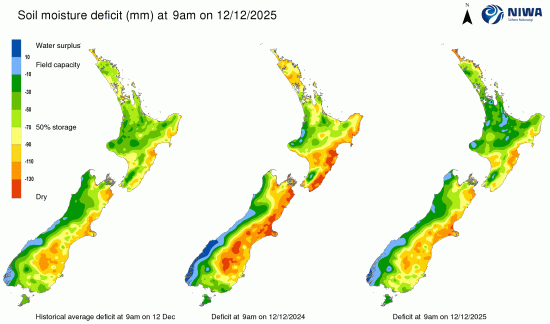
Here's our summary of key economic events overnight that affect New Zealand, with news away from intended the distraction of a great power meeting, the concerns about the future by consumers are building and that is crimping their economic activity. Not only in the US, but China as well.
US retail sales rose +0.5% in July from June, largely as expected and following an upwardly revised 0.9% rise in June. This was largely due to car buying. There are up +3.9% from a year ago and that gain has been falling from the recent +5.1% peak in March. Although tariff-taxes account for most of the gain, overall there is a small rela gain here. But without cars, this would look quite negative.
In the New York region, they saw a modest rise in business activity in their factories in July based on rising new orders.
And that is supported by national industrial output data. American industrial production edged down -0.1% in July, missing forecasts of a flat reading and following an upwardly revised +0.4% rise in June. But the decline was only because the mining sector was weak. Factory output, which makes up about 78% of total industrial production, edged up +0.1% in July, after increasing +0.3% in June. From year-ago levels it is up +1.4%, similar to most of 2025.
Not so positive is consumer sentiment as they don't like what they see ahead. The University of Michigan consumer sentiment August survey fell sharply from July and well below what was expected. It was the first fall in four months, mainly due to growing inflation concerns and sharply worse buying conditions for durable goods. Those surveyed anticipate worsening inflation and unemployment ahead. Overall this survey is more than -13% worse than year ago levels.
Across the Pacific, Malaysia’s economy expanded by +4.4% year-on-year in the June quarter, matching the pace in Q1 and slightly below the initial estimate of +4.5%.
In China, retail sales rose +3.7% in July from a year ago, slowing from a +4.8% expansion in June. Markets were expecting a +4.6% gain in July, so this is a disappointment. This latest result is their weakest growth since December 2024.
Meanwhile, China's industrial production expanded by +5.7% in July from a year ago, slowing from June’s three-month high of +6.8%. Expectations were for a 5.9% gain so this miss is small. But it is the softest increase in industrial production since last November. That comes after capacity curbs caused by unusually high temperatures and heavy rainfall in some regions.
The more important metric of Chinese electricity production saw it rise +3.1% in July from a year ago, a faster expansion than in June. Hydro power was down -9.8% on the same basis, coal power up +4.3%, and nuclear power up +8.3%. The smaller renewals sector rise much faster than all of these.
China’s new home prices in the 70 major reference cities dropped by -2.8% in July from a year ago, easing from a -3.2% decline in the previous month. It was the 25th consecutive month of contraction, the softest pace since March 2024. Only five of those 70 cities had any increase, and those were all marginal at best. But then again, so were the dips. For resales, there were no cities showing any year-on-year gains and only one (Taiyuan, in Shanxi province) with a monthly gain.
Overall, its a picture of a slightly slowing Chinese economy across all sectors and that will tell Beijing that its stimulus efforts so far are insufficient to keep up with the forces that are dragging it slower. But so far, Bejing is calling the economy 'steady'.
We should note that global shipping costs are starting to be roiled by the new Trump rule of tariff-extras/extra port fees for Chinese-made ships that comes into effect in five weeks. That will raise freight costs for Americans, and with extra capacity in other trades, probably lower costs elsewhere.
And in Europe, data released overnight shows that Ireland's exports to the US dropped by almost a quarter in June compared to a year ago. Tariffs got the blame. (But they were able to reorient about half of that drop to the UK.)
In the UK, German car maker Volkswagen has introduced a subscription for UK customers wanting to increase the power of some of its electric cars. Those who buy an eligible car in its ID.3 range can choose to pay extra if they want to unlock the full power of the engine inside the vehicle. The "optional power upgrade" will cost £16.50 per month or £165 annually - or people can choose to pay £649 for a lifetime subscription.
The UST 10yr yield is now at 4.32%, up another +4 bps from yesterday at this time, up +3 bps for the week. The key 2-10 yield curve is steeper at +57 bps. Their 1-5 curve is now inverted by -8 bps. And their 3 mth-10yr curve is still inverted by -3 bps. The Australian 10 year bond yield starts today at 4.27% and up +3 bps and unchanged for the week. The China 10 year bond rate is up +1 bp at 1.74%. The NZ Government 10 year bond rate starts today at just on 4.45% and up +2 bps, up the same for the week.
Wall Street is marginally softer again in Friday trade, down -0.3%, wavering after yesterday's PPI inflation result. But it is still up +0.9% for the week. Overnight European markets were mixed between's London's -0.4% fall and Paris's +0.7% rise. Tokyo ended its Friday session up +1.7% to book an impressive weekly rise of +5.1%. Hong Kong however fell -1.0% but was still up +1.3% for the week. Shanghai rose +0.8% on Friday ending up +1.6% for the week. Singapore fell -0.6% in its Friday session. The ASX200 ended its Friday up +0.7% for a weekly +1.4% gain. And the NZX50 rose +0.4% for a weekly similar +0.4% weekly advance.
The Fear & Greed index his still in the 'greed' zone same as it was last week.
The price of gold will start today at US$3,334/oz, down -US$1 from yesterday, but down -US$61 for the week.
American oil prices have fallen -US$1 to be just under US$63/bbl with the international Brent price under US$66/bbl. These levels are $2 lower that a week ago in the US, and -50 USc lower for the Brent price.
The Kiwi dollar is at just over 59.2 USc and up +20 bps from yesterday. But it is down -40 bps from a week ago. Against the Aussie we are unchanged at 91.1 AUc. Against the euro we are down -20 bps at 50.6 euro cents. That all means our TWI-5 starts today at just on 66.9, essentially unchanged from yesterday but down -40 bps for the week.
The bitcoin price starts today at US$117,422 and down -0.3% from this time yesterday. But up +0.5% from a week ago. Volatility over the past 24 hours has been low at just under +/-1.0%.
Daily exchange rates
Select chart tabs
The easiest place to stay up with event risk is by following our Economic Calendar here ».
4 Comments
the Volkswagon subscription thing is weird. It's there all the time anyway. But you pay more to access it ?????
It's weird and has probably already been hacked.
Reminds me of my kid's school which seems to be an arms race between the school banning websites and the kids finding new VPN sites that bypass all the controls
This news is not new news. Bunch of subscription based features around now.
Americans have long loved London. As prices for high-end homes fall, U.S. buyers are swooping in to take advantage of real-estate bargains.
https://www.wsj.com/real-estate/luxury-homes/americans-are-snapping-up-…



We welcome your comments below. If you are not already registered, please register to comment
Remember we welcome robust, respectful and insightful debate. We don't welcome abusive or defamatory comments and will de-register those repeatedly making such comments. Our current comment policy is here.